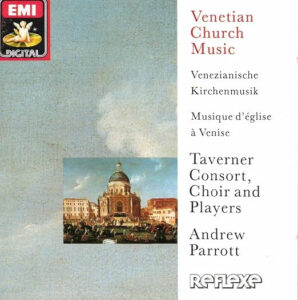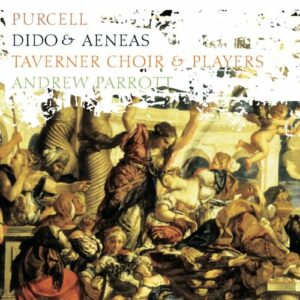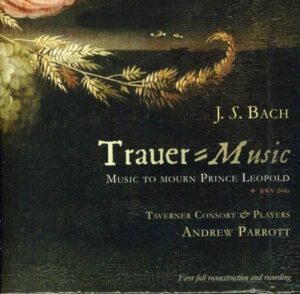Program: #23-43 Air Date: Oct 23, 2023
To listen to this show, you must first LOG IN. If you have already logged in, but you are still seeing this message, please SUBSCRIBE or UPGRADE your subscriber level today.
There are few major figures in the field we have not had as a guest in our program’s history; one of these is the great Andrew Parrott with his Taverner Consort. This week, music of Grandi, Lotti, Purcell, and Bach.
NOTE: All of the music on this program comes from the ensemble the Taverner Choir directed by our guest Andrew Parrott.
For complete information about this ensemble:
I. Venetian Church Music. EMI CD CDC 7 54117-2.

From Gramophone: One of the curiosities of the history of Venetian music is that its first great period, including the work of Andrea and Giovanni Gabrieli, Claudio Monteverdi and his contemporaries, begins more or less at the point that the Renaissance in painting comes to an end with deaths of Titian and Tintoretto. Between these origins and the time of Vivaldi who died in 1741, there is a rich and continuous tradition in Venetian church music, for all that we tend to be familiar with the repertories at either end of that spectrum rather than those in between. But in the middle, comparatively undiscovered and unperformed, there is a rich seam of fine music by composers such as Alessandro Cavalli, Francesco Cavalli, Giovanni Legrenzi and Antonio Lotti, much of it written for St Mark's Basilica, the principal musical establishment of the city throughout the period.
One of the delights of the present record is that it brings to life a well-chosen selection of these less familiar corners of the Venetian musical world, in particular some intriguing examples from some of the largely forgotten moments in the tradition of instrumental music. There is, for example, Dario Castello's Sonata seconda, a tightly-constructed and economical piece which is here given a virtuosic and at times almost rhapsodic performance by John Holloway. But at the centre of this record is the Venetian choral tradition, and appropriately enough it opens with one of the great monuments of that repertory, Giovanni Gabrieli's In ecclesiis. It is interesting to compare this interpreatation with Andrew Parrot's 1978 L'Oiseau-Lyre Florilegium recording (nla), also made with the Taverners; the new recording gains from a more leisurely and expansive view of the work (at 8'14'' it is more than a minute longer than the older recording) which leads to a performance that is at the same time both stately and sensuous. As with Gabrieli's Canzon VIII a 8, there is some sensational passagework from the cornettists here, a good demonstration of how rapidly standards have changed in this area of period-instrument performance in the last decade or so. In general terms a very high level of achievement is displayed throughout in a sequence of intelligent and carefully-controlled performances that nevertheless sometimes seems to lack the vital ingredient of musical flair.
| 1 | Intonationi d'organo: Intonation del non tono | Giovanni Gabrieli | 0:44 |
| 2 | Symphoniæ sacræ 11: In ecclesiis a 14 | Giovanni Gabrieli | 8:12 |
| 3 | Motetti in lode d'Iddio nostro Signore: Adoramus te, Christe a 6 | Claudio Monteverdi | 4:43 |
| 4 | Ghirlanda sacra: O quam pulchra es | Alessandro Grandi | 3:43 |
| 5 | Sonate concertante, libro secondo: Sonata seconda | Dario Castello | 4:38 |
| 6 | Arie de diversi: Exulta, filia Sion | Claudio Monteverdi | 5:09 |
| 7 | Sonata da chiesa a 3, op. 8 no. 8 "La Bevilaqua": Allegro - Adagio - Allegro - Adagio - Presto allegro | Giovanni Legrenzi | 5:17 |
| 8 | Crucifixus a 10 | Antonio Lotti | 2:33 |
| 9 | Clarae stellae, scintillate, RV 625: I. Aria "Clarae stellae, scintillate" recording of: Clarae stellae, scintillate, RV 625: I. "Clarae stellae scintillate" (Allegro) composer: Antonio Vivaldi part of: Clarae stellae, scintillate, RV 625 |
Antonio Vivaldi | 5:37 |
| 10 | Clarae stellae, scintillate, RV 625: II. Recitativo "Coeli repleti lam novo splendore" recording of: Clarae stellae, scintillate, RV 625: II. Recitativo "Coeli repleti iam novo splendore" composer: Antonio Vivaldi part of: Clarae stellae, scintillate, RV 625 |
Antonio Vivaldi | 0:47 |
| 11 | Clarae stellae, scintillate, RV 625: III. Aria "Nunc jubilare" recording of: Clarae stellae, scintillate, RV 625: III. "Nunc iubilare" (Allegro) composer: Antonio Vivaldi part of: Clarae stellae, scintillate, RV 625 |
Antonio Vivaldi | 2:44 |
| 12 | Clarae stellae, scintillate, RV 625: IV. Alleluia recording of: Clarae stellae, scintillate, RV 625: IV. Alleluia (Allegro) composer: Antonio Vivaldi part of: Clarae stellae, scintillate, RV 625 |
Antonio Vivaldi | 2:55 |
| 13 | Crucifixus a 6 | Antonio Lotti | 3:15 |
| 14 | Ghirlanda sacra: Currite populi | Claudio Monteverdi | 4:09 |
| 15 | Motteti in lod d'Iddio nostro Signore: Christe, adoramus te | Claudio Monteverdi | 3:01 |
| 16 | Canzoni e sonate: Canzon VIII a 8 | Giovanni Gabrieli | 5:10 |
| 17 | Fuga del non tono | Giovanni Gabrieli | 2:53 |
| 18 | Symphoniæ sacræ: Magnificat a 14 |
II. Purcell: Dido & Aeneas. Sony CD SK 62993.

From BBC Classical Music: This fresh performance, recorded in 1994, places the accent on giving meaning and colour to every word of the text. Those who are looking for big-voiced singers – big-voiced even within the restricted remit of most period-style performance practice – will be disappointed. But not I. Casting Ben Parry as Aeneas was a minor masterstroke. Parry will never strut the stage of the Met – his singing is more akin to what one might expect in a carefully cast musical – but his youthful, slightly husky Aeneas is wholly credible. What better to excuse the Trojan king’s rather odd behaviour than lack of experience? Emily van Evera’s Dido, Jane Lax’s Belinda and Haden Andrews’s Sorceress (Andrews is a bass-baritone) are all equally good, and Parrot directs the excellent Taverner Players in a performance that charms as well as moves in abundance. For me its closest rival on CD is Christopher Hogwood’s gripping account on Decca Florilegium. But given a simple choice between the two, I’d walk away with this one.
Artists:
- Emily Van Evera
- Ben Parry
- Taverner Choir & Players
- Andrew Parrott
Tracklist:
HENRY PURCELL (1659–1695)
Libretto by Nahum Tate (1652–1715)
Dido and Aeneas
- Overture (2:14)
ACT I · Scene: The Palace
- Shake the cloud from off your brow (1:11)
- Ah! Belinda, I am pressed with torment (3:55)
- Grief increases by concealing (0:44)
- When monarchs unite, how happy their state (0:16)
- Whence could so much virtue spring? (1:43)
- Fear no danger to ensue (1:49)
- Dance [Fear no danger to ensue] (0:55)
- See, see, your royal guest appears (0:49)
- Cupid only throws the dart (0:41)
- If not for mine, for empire’s sake (0:21)
- Pursue thy conquest, Love (0:52)
- Dance: ‘Gittars Chacony’ (0:40)
- To the hills and the vales (1:14)
- The Triumphing Dance (1:19)
ACT II · Scene: The Cave
- Prelude for the Witches: Wayward sisters, you that fright (1:56)
- Harm’s our delight (0:14)
- The Queen of Carthage, whom we hate (0:25)
- Ho ho ho! (0:09)
- Ruined ere the set of sun? (1:02)
- Ho ho ho! (0:09)
- But ere we this perform (1:14)
- In our deep vaulted cell (1:07)
- Echo Dance of Furies (1:07)
- Ritornelle (0:54)
- Thanks to these lonesome vales (2:47)
- Dance: ‘Gitter Ground’ (2:23)
Oft she visits this lone mountain
A Dance to entertain Aeneas by Dido’s women - Behold, upon my bending spear (0:34)
- Haste, haste to town! (0:50)
- Stay, Prince, and hear great Jove’s command (2:35)
- [Dance: Hornpipe from The Married Beau] (0:49)
ACT III · Scene: The Ships
- Prelude: Come away, fellow sailors (1:34)
- The Sailors’ Dance (0:46)
- See the flags and streamers curling (0:58)
- Our next motion (0:33)
- Destruction our delight (0:34)
- The Witches’ Dance (1:12)
- Your counsel all is urg’d in vain (3:54)
- Great minds against themselves conspire (0:58)
- Thy hand, Belinda; darkness shades me (0:47)
- When I am laid in earth (3:41)
- With drooping wings (2:15)
- Cupids’ Dance (2:36)
- Pavan in G minor z752 for three violins and continuo (5:08)
III. Bach: Trauer-Music. Avie CD AV2271.

Bach's lost Cöthen funeral music (1729) has received little attention since it became clear that it could not have been a model for parts of the great St Matthew Passion but rather the reverse. With one exception, all arias and choruses of Bach's final tribute to Prince Leopold are clear parodies of music from the Passion or from the 1727 Trauer Ode ('Laß, Fürstin'). The proposal that the one unidentifiable item might easily have been the eminently suitable fugal chorus from the Trauer Ode opens up the possibility of some sort of plausible reconstruction, although the ten recitatives remain unrecoverable. Leopold's funeral comprised two services—Burial and Memorial—just a few hours apart. Reconciling the four discrete parts of Picander's text with the total of four musical 'slots' in the precisely documented ceremonies strongly suggests that the printed libretto (perhaps a commemorative publication) is misleading. With the 'burial' sequence duly repositioned, a more convincing musical architecture emerges and the notion of a second lost piece of Trauer-Music, 'of which not even the text survives', is rendered redundant.
Andrew Parrott is a master of musicological detective work known for his adventurous and uncompromising scholarship. He is also internationally known for his pioneering historically informed performances and recordings of pre-classical repertory. This new release combines the best of both, resulting in the first full reconstruction and recording of the funeral music for J.S. Bach’s patron, Prince Leopold of Cöthen. Bach’s years in Cöthen were musically fertile and Prince Leopold was a knowledgeable and committed supporter of music and the arts, so it’s ironic that much of Bach’s output during those years has been lost or even destroyed. The score for Trauer-Music, written in 1728 on the occasion of the Prince’s sudden death at the age of 34, has almost completely disappeared, yet through the discovery of numerous clues in other works and writings, Parrott has been able to reconstruct what was clearly a heart-felt homage.
Parrott conducts the renowned Taverner Consort and Players, the organisation he founded in 1973, and a superb roster of baroque vocal soloists. A unique document and superb performance make this a recording for classical music aficionados and lovers of Bach’s music alike.
JOHANN SEBASTIAN BACH (1685–1750)
Trauer Music for Prince Leopold
Burial Service
AT THE ARRIVAL OF THE COFFIN
- aria (B) Laß, Leopold, Dich nicht begraben (6.03)
- recitativo (A) Wie kont es möglich seyn (1.02)
- aria (B) Wird auch gleich nach tausend Zähren (4.06)
- recitativo (T) Und, Herr, das ist die Specerey (0.44)
- ‘aria a 2. Chören’ (T) Geh, Leopold, zu Deiner Ruh (5.43)
Memorial Service
FOLLOWING THE ARRIVAL OF THE PRINCIPAL MOURNERS
- coro (‘aria’) Klagt, Kinder (6.28)
- recitativo (T) O Land! Bestürtztes Land! (1.19)
- aria (A) Weh und Ach (4.25)
- recitativo (S) Wie, wenn der Blitze Grausamkeit (1.05)
- aria (S) Zage nur, du treues Land (5.02)
- recitativo (T) Ach ja! Dein Scheiden geht uns nah (1.20)
- coro (‘aria’) Komm wieder, Theurer Fürsten-Geist (5.14)
FOLLOWING THE SERMON
- coro Wie haben einen Gott, der da hilfft (1.52)
- recitativo (A) Betrübter Anblick, voll Erschrecken ( 0.44)
- aria (A) Erhalte mich Gott (6.16)
- recitativo (S) Jedoch der schwache Mensche zittert nur (1.03)
- aria (S) Mit Freuden sey die Welt verlassen (5.07)
- recitativo (T) Wohl also Dir, Du aller Fürsten Zier (0.20)
- coro (repeat of 13) Wie haben einen Gott, der da hilfft (1.59)
FOLLOWING THE CURRICULUM VITÆ AND THE PRAYERS
- aria (B) Bleibet nun in eurer Ruh (6.33)
- recitativo (T) Und Du betrübtes Fürsten-Hauß (1.08)
- aria (S) Hemme Dein gequältes Kräncken (3.30)
- recitativo (T) Nun scheiden wir, Hochseelger Leopold, von Dir (1.11)
- coro (‘aria tutti’) Die Augen sehn nach Deiner Leiche (6.26)
Composer Info
Giovanni Gabrieli, Claudio Monteverdi, Alessandro Grandi, Dario Castello, Giovanni Legrenzi, Antonio Lotti, Antonio Vivaldi, HENRY PURCELL (1659–1695), Nahum Tate (1652–1715), JOHANN SEBASTIAN BACH (1685–1750),
CD Info
EMI CD CDC 7 54117-2, Sony CD SK 62993, Avie CD AV2271